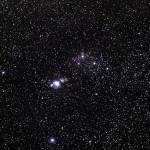

View at EarthSky Community Photos. | Kannan A in Woodlands, Singapore, captured this photo of the first quarter moon on January 20, 2021. He wrote: “The first quarter moon in Singapore seen overhead at a distance of 403,606 km [250,789 miles] from Earth and 46.4% illuminated. Despite partially cloudy skies, the moon was clear and visible.” Thanks, Kannan! The moon and its terminator are great targets for binocular observing.
When should you begin observing the heavens with binoculars? Now! It’s a great way to get a closer look at the beauties of the universe, without having to buy and learn to use a telescope. Binoculars have other advantages over telescopes, too, including being less expensive, easier to store and easier to transport. A good pair of binoculars can give you a new perspective on some wonderful objects in the night sky, including the moon, planets, double stars, star clusters and nebulae, and even galaxies. If you’ve never considered stargazing with binoculars, become acquainted with our top tips for binocular stargazing here.
And if you’ve got your binoculars in hand and a clear sky tonight, read on for a list of easy targets to observe.
The moon is the best target to start with because it’s easy to find and never disappoints. As our closest neighbor in the solar system, you can see detail on the moon that you could only dream of seeing on other worlds. Start at the moon’s terminator, the dividing line between light and shadow, or day and night, on the moon. This is the line of sunrise, or sunset, on the moon. And just as the shadows on Earth are longest around earthly sunrise or sunset, so it is with lunar shadows. The terminator slices across lunar valleys and mountains, with their long shadows allowing them to stand out in stark relief. Look for rilles; the huge, dark maria (dry lava beds); and craters where brighter debris has splashed across the moon’s surface.
The planets are your next step out from the moon, and the king planet Jupiter is one of your best binocular targets. It should resolve as a disk instead of a point, and you can track this world’s four largest moons as they disappear and reappear from behind Jupiter in their waltzing orbits. You won’t see Saturn’s rings with binoculars; you need a telescope for that. But you might be able to perceive Saturn’s rings as “bulges” that give the planet an elongated look. Likewise, the phases of Venus are best seen through a telescope. But – when it’s near Earth and in a thin crescent phase – binoculars will show you that Venus isn’t perfectly round. And Mars? Your binoculars will intensify the red-orange color of Mars. They’ll also let you more easily spot Uranus – the most distant planet visible to the eye alone – even if your sky is less than optimum. Finally, your binoculars will let you go deep in search of Neptune, the only major planet that requires binoculars to be seen.

Jupiter and its four largest moons, the Galilean satellites. From bottom to top: Callisto, Ganymede, Europa, and Io. Photo captured March 14, 2017, by Suzanne Murphy in Wisconsin.
Beyond our solar system, the Milky Way is filled with excellent observing targets, from double stars to star clusters to nebulae.
Double stars are your next binocular target. Start with the easy pair of Mizar and Alcor, located at the bend of the handle in the Big Dipper. If you have decent eyesight you can separate these two without binoculars, but with binoculars you can see what differences there are between the stars in brightness, size and color. These two stars appear 12 arc minutes apart from our point of view. If that was too easy, try Theta Tauri. At 5 1/2 arc minutes apart, the two components of Theta Tauri might be accessible to some with the eye alone, but binoculars will make the separation obvious. Theta Tauri, at magnitude 3.8, is found in the V-shape of Taurus’ head, just down from the bright, reddish Aldebaran. Can you use your binoculars to spot spot a yellowish color in Theta 1 and a bluish hue in Theta 2?
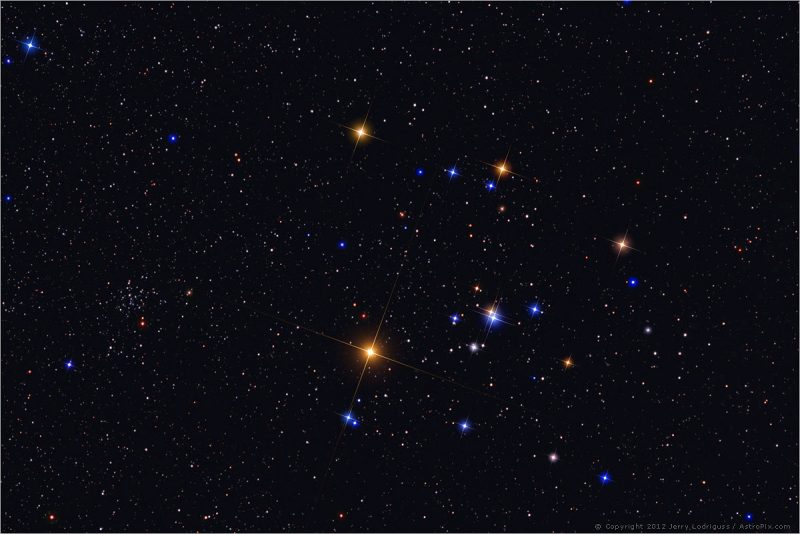
The Hyades star cluster. Can you spot the double star Theta in the V-shaped head of Taurus the Bull? Image via Jerry Lodriguss/ AstroPix.com.
Open star clusters are groups of young stars born together out of the same cloud of gas. This type of cluster is best represented in binoculars by the Pleiades Cluster in Taurus, a fuzzy patch of six to seven stars seen with the unaided eye, and the Beehive Cluster at the center of Cancer. The Pleiades, aka M45, is a 1.6-magnitude grouping that looks best in binoculars because a telescope cannot contain its wide expanse. Suddenly those six stars turn into 30 to 70, depending on your binoculars and the quality of your night sky. The Beehive Cluster, or M44, is a 3.4-magnitude arrangement that can also be seen with the naked eye, but becomes more profuse in binoculars. Through his primitive telescope, Galileo could see more than 40 stars. How many can you see in binoculars? In the Southern Hemisphere, the Jewel Box cluster, in the constellation Crux, is one of the youngest known clusters at 14 million years old. Can you spot a pyramidal shape to the cluster through binoculars?
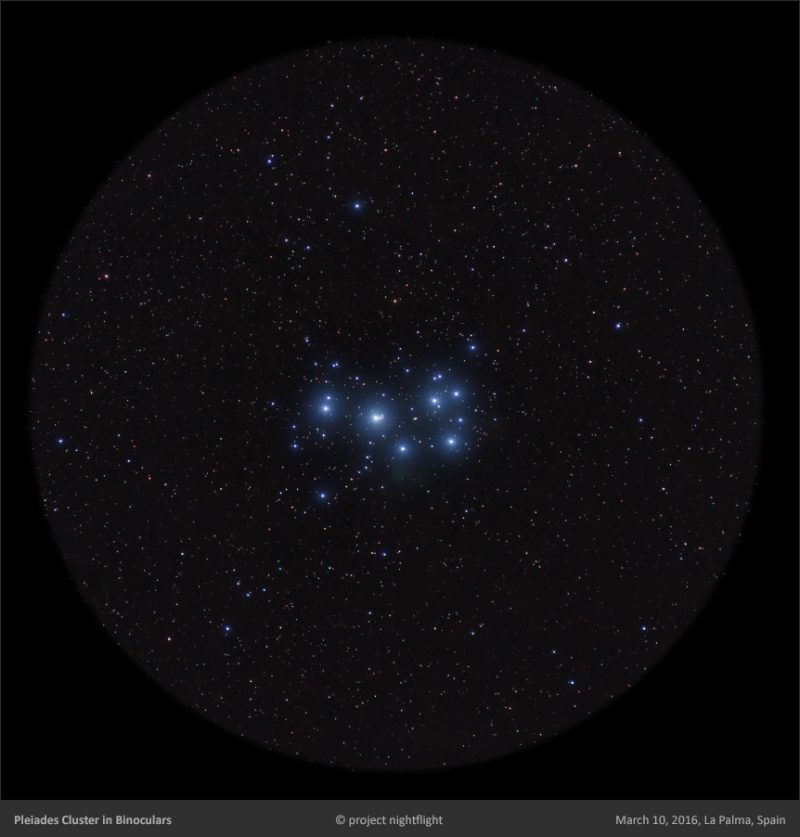
The Pleiades Cluster, M45, as it looks through binoculars. Image via Project Nightflight.
Globular star clusters look very different from open star clusters. Each one is a huge conglomeration of ancient stars at the edges of our Milky Way. In the Northern Hemisphere, target the Great Cluster in Hercules, aka M13. The globular cluster is on the western edge of a noticeable star pattern – an asterism – within Hercules. This asterism is called The Keystone. At magnitude 5.9, you can begin to glimpse some of the hundreds of thousands of stars that swarm tightly within the globular star cluster M13. Another globular, the first to be recognized, is M22 in the constellation Sagittarius the Archer. Sagittarius contains another asterism, called the Teapot, and the whole Teapot region is rich with binocular treasures. M22 is a stunning magnitude 5.1 cluster, just above and to the left of the Teapot’s lid.
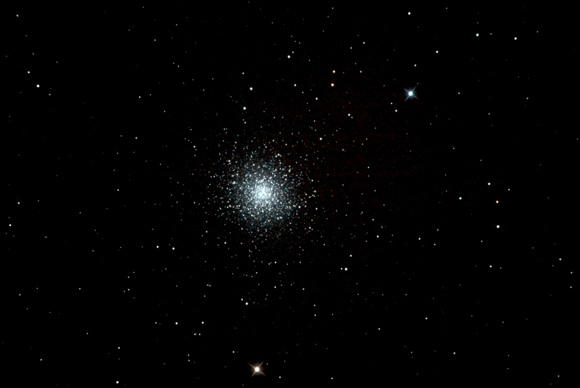
Globular star clusters are symmetrical balls of stars. This photo of the Great Cluster in Hercules was taken by John Giroux.
Nebulae, or clouds in space, come in both light and dark. The best-known nebula is probably the glittering Orion Nebula, M42, a hazy 4th-magnitude patch on Orion’s sword that can be glimpsed with the unaided eye. Binoculars enhance this view, as several stars cast their light onto the gas cloud, making it glow. Another nebula for binoculars is the Lagoon Nebula, M8, in Sagittarius, not far from our earlier star cluster target M22. Above the spout of the teapot asterism of Sagittarius, imagine steam flowing upward. This stretch of the Milky Way, filled with beautiful targets, contains M8, which, at magnitude 5.8, is more of a challenge than Orion. Another even more difficult nebula lies right next to M8. M20, the Trifid Nebula, is recognizable by the darker dust lanes dividing this nebula into three parts. Make sure you are observing from a dark-sky location to have a chance at this magnitude 6.3 gas cloud.

View larger. | The Orion Nebula is a hazy patch on Orion’s sword visible even without binoculars. Image via ESO/ S. Brunier.
Galaxies are the building blocks of our universe, and they’re our last stop as we head deeper into the greater universe. Use your binoculars to start with the obvious – the galaxy next door to ours, the Andromeda Galaxy, aka M31. The magnitude-3.5 spiral can be spotted below the W-shape of Cassiopeia as an elongated fuzzy blob. Two 8th-magnitude companions lie along the disk of Andromeda; they’re a real challenge to glimpse in binoculars, but it’s possible. Another option for binocular observing is the pair of galaxies in Ursa Major, M81 and M82, at magnitude 6.9 and 8.4 respectively, which will be a decent challenge. These north circumpolar galaxies are up every night of the year for those in the Northern Hemisphere. M81 should be the easier catch, with the spiral galaxy being close to face on, while M82 is dimmer and shows just its profile.
What are your favorite objects to target in binoculars? Share with us in the comments below.
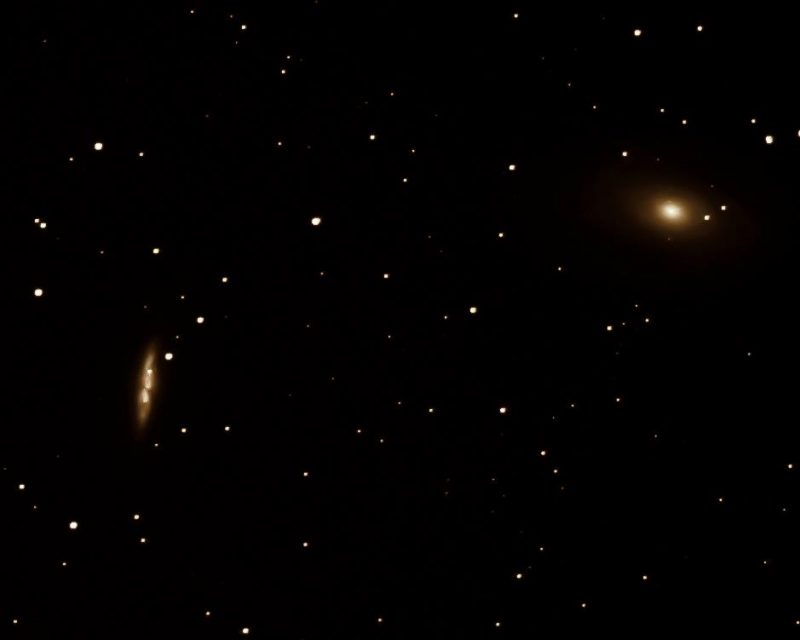
M81, right, is a nearly face-on spiral galaxy sometime’s called Bode’s Nebula and M82, left, has the nickname the Cigar Galaxy. Our friend Ken Christison captured this beautiful telescopic image. He said it’s a stack of 15 images of 30 seconds.
Bottom line: Binoculars open up new territory for stargazers, letting us view details on the moon, swirling satellites around Jupiter, colorful double stars, billowing clouds of gas, and even distant galaxies.
A few 2021 lunar calendars left! Order yours before they’re gone.
from EarthSky https://ift.tt/2OZ0ae8


View at EarthSky Community Photos. | Kannan A in Woodlands, Singapore, captured this photo of the first quarter moon on January 20, 2021. He wrote: “The first quarter moon in Singapore seen overhead at a distance of 403,606 km [250,789 miles] from Earth and 46.4% illuminated. Despite partially cloudy skies, the moon was clear and visible.” Thanks, Kannan! The moon and its terminator are great targets for binocular observing.
When should you begin observing the heavens with binoculars? Now! It’s a great way to get a closer look at the beauties of the universe, without having to buy and learn to use a telescope. Binoculars have other advantages over telescopes, too, including being less expensive, easier to store and easier to transport. A good pair of binoculars can give you a new perspective on some wonderful objects in the night sky, including the moon, planets, double stars, star clusters and nebulae, and even galaxies. If you’ve never considered stargazing with binoculars, become acquainted with our top tips for binocular stargazing here.
And if you’ve got your binoculars in hand and a clear sky tonight, read on for a list of easy targets to observe.
The moon is the best target to start with because it’s easy to find and never disappoints. As our closest neighbor in the solar system, you can see detail on the moon that you could only dream of seeing on other worlds. Start at the moon’s terminator, the dividing line between light and shadow, or day and night, on the moon. This is the line of sunrise, or sunset, on the moon. And just as the shadows on Earth are longest around earthly sunrise or sunset, so it is with lunar shadows. The terminator slices across lunar valleys and mountains, with their long shadows allowing them to stand out in stark relief. Look for rilles; the huge, dark maria (dry lava beds); and craters where brighter debris has splashed across the moon’s surface.
The planets are your next step out from the moon, and the king planet Jupiter is one of your best binocular targets. It should resolve as a disk instead of a point, and you can track this world’s four largest moons as they disappear and reappear from behind Jupiter in their waltzing orbits. You won’t see Saturn’s rings with binoculars; you need a telescope for that. But you might be able to perceive Saturn’s rings as “bulges” that give the planet an elongated look. Likewise, the phases of Venus are best seen through a telescope. But – when it’s near Earth and in a thin crescent phase – binoculars will show you that Venus isn’t perfectly round. And Mars? Your binoculars will intensify the red-orange color of Mars. They’ll also let you more easily spot Uranus – the most distant planet visible to the eye alone – even if your sky is less than optimum. Finally, your binoculars will let you go deep in search of Neptune, the only major planet that requires binoculars to be seen.

Jupiter and its four largest moons, the Galilean satellites. From bottom to top: Callisto, Ganymede, Europa, and Io. Photo captured March 14, 2017, by Suzanne Murphy in Wisconsin.
Beyond our solar system, the Milky Way is filled with excellent observing targets, from double stars to star clusters to nebulae.
Double stars are your next binocular target. Start with the easy pair of Mizar and Alcor, located at the bend of the handle in the Big Dipper. If you have decent eyesight you can separate these two without binoculars, but with binoculars you can see what differences there are between the stars in brightness, size and color. These two stars appear 12 arc minutes apart from our point of view. If that was too easy, try Theta Tauri. At 5 1/2 arc minutes apart, the two components of Theta Tauri might be accessible to some with the eye alone, but binoculars will make the separation obvious. Theta Tauri, at magnitude 3.8, is found in the V-shape of Taurus’ head, just down from the bright, reddish Aldebaran. Can you use your binoculars to spot spot a yellowish color in Theta 1 and a bluish hue in Theta 2?

The Hyades star cluster. Can you spot the double star Theta in the V-shaped head of Taurus the Bull? Image via Jerry Lodriguss/ AstroPix.com.
Open star clusters are groups of young stars born together out of the same cloud of gas. This type of cluster is best represented in binoculars by the Pleiades Cluster in Taurus, a fuzzy patch of six to seven stars seen with the unaided eye, and the Beehive Cluster at the center of Cancer. The Pleiades, aka M45, is a 1.6-magnitude grouping that looks best in binoculars because a telescope cannot contain its wide expanse. Suddenly those six stars turn into 30 to 70, depending on your binoculars and the quality of your night sky. The Beehive Cluster, or M44, is a 3.4-magnitude arrangement that can also be seen with the naked eye, but becomes more profuse in binoculars. Through his primitive telescope, Galileo could see more than 40 stars. How many can you see in binoculars? In the Southern Hemisphere, the Jewel Box cluster, in the constellation Crux, is one of the youngest known clusters at 14 million years old. Can you spot a pyramidal shape to the cluster through binoculars?

The Pleiades Cluster, M45, as it looks through binoculars. Image via Project Nightflight.
Globular star clusters look very different from open star clusters. Each one is a huge conglomeration of ancient stars at the edges of our Milky Way. In the Northern Hemisphere, target the Great Cluster in Hercules, aka M13. The globular cluster is on the western edge of a noticeable star pattern – an asterism – within Hercules. This asterism is called The Keystone. At magnitude 5.9, you can begin to glimpse some of the hundreds of thousands of stars that swarm tightly within the globular star cluster M13. Another globular, the first to be recognized, is M22 in the constellation Sagittarius the Archer. Sagittarius contains another asterism, called the Teapot, and the whole Teapot region is rich with binocular treasures. M22 is a stunning magnitude 5.1 cluster, just above and to the left of the Teapot’s lid.

Globular star clusters are symmetrical balls of stars. This photo of the Great Cluster in Hercules was taken by John Giroux.
Nebulae, or clouds in space, come in both light and dark. The best-known nebula is probably the glittering Orion Nebula, M42, a hazy 4th-magnitude patch on Orion’s sword that can be glimpsed with the unaided eye. Binoculars enhance this view, as several stars cast their light onto the gas cloud, making it glow. Another nebula for binoculars is the Lagoon Nebula, M8, in Sagittarius, not far from our earlier star cluster target M22. Above the spout of the teapot asterism of Sagittarius, imagine steam flowing upward. This stretch of the Milky Way, filled with beautiful targets, contains M8, which, at magnitude 5.8, is more of a challenge than Orion. Another even more difficult nebula lies right next to M8. M20, the Trifid Nebula, is recognizable by the darker dust lanes dividing this nebula into three parts. Make sure you are observing from a dark-sky location to have a chance at this magnitude 6.3 gas cloud.

View larger. | The Orion Nebula is a hazy patch on Orion’s sword visible even without binoculars. Image via ESO/ S. Brunier.
Galaxies are the building blocks of our universe, and they’re our last stop as we head deeper into the greater universe. Use your binoculars to start with the obvious – the galaxy next door to ours, the Andromeda Galaxy, aka M31. The magnitude-3.5 spiral can be spotted below the W-shape of Cassiopeia as an elongated fuzzy blob. Two 8th-magnitude companions lie along the disk of Andromeda; they’re a real challenge to glimpse in binoculars, but it’s possible. Another option for binocular observing is the pair of galaxies in Ursa Major, M81 and M82, at magnitude 6.9 and 8.4 respectively, which will be a decent challenge. These north circumpolar galaxies are up every night of the year for those in the Northern Hemisphere. M81 should be the easier catch, with the spiral galaxy being close to face on, while M82 is dimmer and shows just its profile.
What are your favorite objects to target in binoculars? Share with us in the comments below.

M81, right, is a nearly face-on spiral galaxy sometime’s called Bode’s Nebula and M82, left, has the nickname the Cigar Galaxy. Our friend Ken Christison captured this beautiful telescopic image. He said it’s a stack of 15 images of 30 seconds.
Bottom line: Binoculars open up new territory for stargazers, letting us view details on the moon, swirling satellites around Jupiter, colorful double stars, billowing clouds of gas, and even distant galaxies.
A few 2021 lunar calendars left! Order yours before they’re gone.
from EarthSky https://ift.tt/2OZ0ae8

Aucun commentaire:
Enregistrer un commentaire